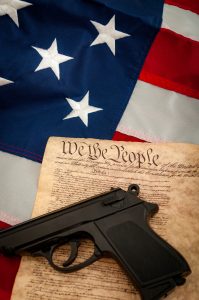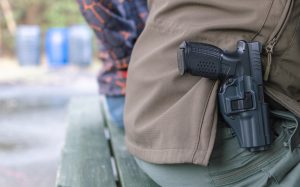Oklahoma Bar Journal
The New Second Amendment Frontier: Litigating the Constitutionality of Firearm Offenses Under Bruen’s Text-and-History Standard
By John D. Russell, Andrew J. Hofland and Justin A. Lollman

Victor Moussa | #113582254 | stock.adobe.com
Last year, in New York State Rifle & Pistol Ass’n, Inc. v. Bruen,[1] the Supreme Court, for the first time, announced a standard for deciding the constitutionality of firearm regulations under the Second Amendment. The test is unlike anything you learned in law school. It doesn’t ask how important or compelling the state’s interest is in a challenged regulation, whether the means of regulation used are substantially related or narrowly tailored to that interest or the degree to which the challenged regulation burdens the right invoked.
Instead, Bruen announced an entirely new two-step test “rooted in the Second Amendment’s text, as informed by history.”[2] At step one, Bruen requires lower courts, when examining a firearm regulation, to ask whether “the Second Amendment’s plain text covers an individual’s conduct.”[3] If it does, “The Constitution presumptively protects that conduct.” At that point, the court must turn to the second step, where the burden falls on the government to “justify its regulation by demonstrating that [the challenged regulation] is consistent with the Nation’s historical tradition of firearm regulation” – that is, the tradition in existence “when the Bill of Rights was adopted in 1791.”[4] If the government fails to carry this burden, the challenged regulation is unconstitutional.[5]
For criminal practitioners, the implications of Bruen are extensive. No other constitutional right is subject to more criminal regulation than the Second Amendment, with many of those regulations being of mid-to-late 20th-century vintage – too late to be considered part of “the Nation’s historical tradition of firearm regulation” under Bruen. Bruen’s implications are only now beginning to play out in the lower courts, with some of the most commonly prosecuted firearm offenses facing new challenges in light of Bruen’s rigorous text-and-history standard. Attorneys prosecuting and defending these cases – in particular, defending – should be on the lookout for these issues and prepared to argue them. This article provides a roadmap for doing just that, describing Bruen’s holding, its significance and potential future implications.
THE LAY OF THE LAND BEFORE BRUEN
The Second Amendment provides, “A well regulated Militia, being necessary to the security of a free State, the right of the people to keep and bear Arms, shall not be infringed.”[6] In the years leading up to Bruen, the Supreme Court held, in District of Columbia v. Heller, that the Second Amendment “protects an individual right to possess firearms”[7] and, in McDonald v. City of Chicago, that this right ranks “fundamental” and thus applicable against the states under the 14th Amendment.[8] Yet, aside from these narrow holdings, neither Heller nor McDonald provided a test or standard for deciding the constitutionality of firearm regulations under the amendment.[9]
In the years following these decisions, lower courts across the country, including the 10th Circuit, coalesced around a deferential two-part “means-end” balancing test.[10] That test required courts to first determine whether the challenged law regulates activity falling outside the scope of the Second Amendment right as originally understood.[11] If so, the activity is unprotected, and the analysis is over.[12] If not, the analysis would proceed to the second step, where the court was to analyze how closely the law comes to the core of the Second Amendment’s right and the severity of the law’s burden on that right.[13] Laws burdening a “core” Second Amendment right were subject to strict scrutiny.[14] All others were subject to intermediate scrutiny.[15]
THE BRUEN DECISION
Bruen involved a Second Amendment challenge to New York’s discretionary “may issue” gun licensing statute. That statute criminalized gun possession, whether inside or outside the home, without a license.[16] For those wishing to carry a firearm outside the home, the applicant was required to convince a licensing officer, usually a judge or law enforcement officer, that they had “proper cause” for doing so.[17] While not defined by statute, New York courts had interpreted this “proper cause” standard as requiring license applicants to “demonstrate a special need for self-protection distinguishable from that of the general community.”[18] Application of this “special need” requirement by licensing officers was demanding, discretionary and subject to highly deferential judicial review.[19]
The petitioners in Bruen, Brandon Koch and Robert Nash, were two law-abiding New York residents, both of who had applied for and been denied a license to carry a firearm outside the home for self-defense.[20] After their applications were denied, Mr. Koch and Mr. Nash filed suit in federal district court against the state officials responsible for overseeing and processing license applications, arguing the New York licensing statute was unconstitutional under the Second Amendment.[21] The district court dismissed the case, and the 2nd Circuit affirmed.[22]
In a 6-3 decision, the Supreme Court reversed.[23] In doing so, the court, for the first time, announced a test for deciding constitutional challenges under the Second Amendment, expressly disavowing the “means-end” balancing test adopted by every circuit court to address the issue.[24] As described above, Bruen established a two-part text-and-history test – a standard devoid of any judicial “interest balancing,” like the “tiers of scrutiny” (rational basis, intermediate scrutiny, strict scrutiny) commonly applied under other constitutional amendments.[25] But the court did not stop there. It then went on to describe and apply this new standard, doing so in thorough, didactic detail over the course of its 63-page opinion. As explained below, the court’s analysis and application yield several important lessons.
Bruen Step One: Does the Second Amendment’s Plain Text Cover the Regulated Conduct?
At step one of the Bruen analysis, the court asks whether “the Second Amendment’s plain text covers the [regulated] conduct.”[26] This step requires “a ‘textual analysis’ focused on the ‘normal and ordinary’ meaning of the Second Amendment’s language”[27] – in particular, the normal and ordinary meaning at the time the Second Amendment was adopted in 1791.[28] “The reason [for this reading] is obvious: the text was adopted by the people in its obvious and general sense.”[29] “[T]he Constitution was written to be understood by the voters.”[30] “[T]he enlightened patriots who framed our constitution, and the people who adopted it,” thus “must be understood to have employed words in their natural sense, and to have intended what they have said.”[31]
The Second Amendment consists of three elements, guaranteeing the right 1) “of the people,” 2) “to keep and bear” and 3) “arms.”[32] These terms have well-established meanings.
“The people.” “The first salient feature of the [Second Amendment’s] operative clause is that it codifies a ‘right of the people.’”[33] “The unamended Constitution and the Bill of Rights use the phrase ‘right of the people’ two other times”: once “in the First Amendment’s Assembly-and-Petition Clause” and again “in the Fourth Amendment's Search-and-Seizure Clause.”[34] The court has interpreted the term “the people” as having a consistent meaning across all three provisions, “refer[ring] to a class of persons who are part of the national community or who have otherwise developed sufficient connections with this country to be considered part of that community.”[35] This broad interpretation reflects the plain meaning of the word the “people” at the time the Bill of Rights was adopted, defined as “every person” or “the whole Body of Persons” comprising a community or nation.[36]
“Keep and bear.” The Second Amendment protects the right to “keep and bear” arms. The word “keep” means “[t]o have in custody” or “retain in one’s power of possession.”[37] The word “bear” means “to ‘carry.’”[38] Both verbs, the court has held, protect the “right to possess firearms”[39] – conduct often criminalized for certain individuals under modern firearm regulations.[40]

stockovari | #256055229 | stock.adobe.com
“Arms.” Finally, the term “arms” refers to “[w]eapons of offense, or armour of defense.”[41] The court has construed the term as “extend[ing] … to all instruments that constitute bearable arms, even those that were not in existence at the time of the founding”[42] and has specifically held that the term protects the right to possess “handguns.”[43]
Bruen Step Two: Is the Challenged Regulation Consistent With the Nation’s Historical Tradition of Firearm Regulation?
If the Second Amendment’s plain text covers an individual’s conduct, “the Constitution presumptively protects that conduct,” thus rendering the regulation presumptively unconstitutional. If the first step is met, the Bruen analysis turns to step two, where the burden falls on the government to “justify its regulation by demonstrating that it is consistent with the Nation’s historical tradition of firearm regulation.”[44] The Bruen analysis at step two involves an “analogical inquiry,” requiring “the government [to] identify a well-established and representative historical analogue” for the challenged regulation.[45] Bruen’s discussion and application of this requirement yields several important lessons. Four stand out in particular.
Burden. First, the burden at step two rests entirely with the government.[46] Courts “are not obliged to sift the historical materials for evidence to sustain the [challenged] statute”[47] but, consistent with ordinary “principle[s] of party presentation,” may “decide a case based on the historical record compiled by the parties.”[48] If that record yields “uncertainties” or is open to “multiple plausible interpretations,” courts should rely on Bruen’s “default rules” – the presumption of unconstitutionality at step one and the government’s burden at step two – “to resolve [those] uncertainties” in favor of the view “more consistent with the Second Amendment’s command.”[49]
Similarity. Second, in identifying a relevant “historical analogue,” not every past practice that “remotely resembles” the challenged regulation will suffice.[50] Rather, to carry its burden, the government must identify a historical regulation that is “relevantly similar” to the one in question, both in terms of “how and why the regulations burden [one’s] right to armed self-defense.”[51] This does not require that the regulations be identical but that they impose “comparable burdens” and be “comparably justified.”[52]
In some cases, this “inquiry will be fairly straightforward.”[53] For example, “When a challenged regulation addresses a general societal problem that has persisted since the 18th century, the lack of a distinctly similar historical regulation addressing the problem is relevant evidence that the challenged regulation is inconsistent with the Second Amendment.”[54] “Likewise, if earlier generations addressed the societal problem, but did so through materially different means, that also could be evidence that a modern regulation is unconstitutional.”[55]
Thus, the “means” by which a regulation is enforced is a crucial factor when comparing “how” two regulations “burden [one’s] right to armed self-defense.”[56] Historical firearm regulations enforced via a “small fine,” “bond,” “forfeiture” or other nonpunitive measures are poor analogues for modern firearm regulations carrying “significant criminal penalties.”[57]
This same reasoning applies when considering a regulation’s scope. Historical practices imposing conditions or restrictions on one’s right to keep and bear arms provide no precedent for a “flat ban” on that right.[58]
Prevalence. Third, the government’s burden at step two of the Bruen analysis does not stop at identifying a relevant historical analogue. Rather, the government must show that the challenged regulation “is consistent with the Nation’s historical tradition of firearm regulation.”[59] This requires more than one or two isolated examples. A tradition of regulation requires a historical practice so “well-established” and “widespread” that a court can say with confidence that the regulated conduct falls outside of “the pre-existing right codified in the Second Amendment.”[60] Although Bruen did not establish any clear threshold for determining when a historical practice rises to the level of a tradition, it did hold that “a single law in a single State” is not enough and even expressed “doubt that three colonial regulations could suffice.”[61]
Time frame. Finally, in weighing historical evidence, courts must take careful account of the relevant time frame. As Bruen notes, “When it comes to interpreting the Constitution, not all history is created equal.”[62] “Constitutional rights are enshrined with the scope they were understood to have when the people adopted them,” which in the case of the Second Amendment was in 1791.[63] As a general rule, the longer a historical regulation predates or postdates this period, the less relevance it carries.[64] For historical analogues long predating the Second Amendment, courts “must be careful” to consider whether “linguistic or legal conventions changed in the intervening period.”[65] While a medieval practice “that prevailed up to the period immediately before and after the framing of the Constitution” may bear on the meaning of the Second Amendment, the same cannot be said for “an ancient practice that had become obsolete in England at the time of the Constitution and never was acted upon or accepted in the colonies.”[66]
This same caution applies with even greater force to post-enactment history. While historical practices “from the early days of the Republic” may be relevant, particularly if “open, widespread, and unchallenged,” the relevance of such practices quickly fades and ultimately vanishes as one approaches the mid-to-late 19th century.[67] Simply put, “The belated innovations of the mid- to late-19th century … come too late to provide insight into the meaning of the Constitution in [1791].”[68] At most, practices from this period can provide “secondary” evidence to bolster or provide “confirmation” of a historical tradition that “had already been established.”[69] Finally, by the time one gets to the 20th century, the relevance of any historical analogues is all but nonexistent, so much so that the court in Bruen declined to “address any of the 20th century historical evidence brought to bear by [the government] or their amici.”[70]
THE POTENTIAL IMPLICATIONS OF BRUEN
Bruen’s text-and-history analysis for evaluating the constitutionality of firearms regulations wiped away years of circuit court authority. The resulting ripple effects will be far-reaching. So far, the most direct challenges have sought to apply Bruen to criminal statutes prohibiting the possession of firearms under certain circumstances. In the early aftermath of Bruen, federal district courts declared certain subsections of 18 U.S.C. §922 unconstitutional: possession of a firearm with an obliterated serial number under 18 U.S.C. §922(k),[71] possession of a firearm while subject to a domestic violence restraining order under 18 U.S.C. §922(g)(8),[72] possession of a firearm by a marijuana user[73] and receipt of a firearm while under felony indictment under 18 U.S.C. §922(n).[74] As additional challenges proliferate around the country, other subsections of §922 not tied to preventing violent felons from possessing firearms will likely be the targets of similar Second Amendment litigation, including, for example, 18 U.S.C. §922(g)(5) (prohibiting firearm possession by illegal aliens), 18 U.S.C. §922(q) (prohibiting firearm possession up to 1,000 feet from a school zone) and even 18 U.S.C. §922(g)(1) (prohibiting the possession of firearms by those with prior felony convictions). Indeed, as a sign of future litigation to come, earlier this year, the 3rd Circuit granted en banc review in an appeal challenging §922(g)(1) under Bruen’s text-and-history standard.[75]
But Bruen also has implications for the criminally accused wherever firearms are a factor within the criminal justice process. Practitioners should analyze current sentencing guidelines related to an offender’s possession of firearms – whether enhancing a base offense level because of the possession of a high-capacity magazine as with U.S. Sentencing Guideline §2K2.1 or overrepresenting a criminal history for a previous firearms offense affected by Bruen – as the possible source for objections, motions for departure or motions for variance considering they stem from conduct arguably protected by the Second Amendment. Onerous bond conditions or pretrial detention based on the existence of a prior firearm possession offense may be susceptible to challenge. Bruen could even have applicability in the Fourth Amendment context. Since Bruen holds that people generally have a constitutional right to carry guns in public, law enforcement may have difficulty basing reasonable suspicion or probable cause on the fact that they see a person simply possessing a handgun.
Bruen leaves open a myriad of challenges to firearm regulation. Every statute, regulation and sentencing enhancement is subject to challenge. If your client is charged with a firearm offense, you should analyze the burden of the regulation through Bruen’s new test. It’s a new day for firearm offenses.
ABOUT THE AUTHORS
 John D. Russell is co-chair of the White Collar Criminal Defense & Corporate Investigations group at GableGotwals. He has more than 30 years’ experience practicing criminal and civil litigation, including service as an assistant U.S. attorney for the Northern District of Oklahoma and a trial attorney for the U.S. Department of Justice, Tax Division.
John D. Russell is co-chair of the White Collar Criminal Defense & Corporate Investigations group at GableGotwals. He has more than 30 years’ experience practicing criminal and civil litigation, including service as an assistant U.S. attorney for the Northern District of Oklahoma and a trial attorney for the U.S. Department of Justice, Tax Division.
 Andrew J. Hofland is a trial lawyer at GableGotwals, who practices in the areas of white-collar criminal defense, administrative law and commercial litigation. He previously served as an assistant U.S. attorney for the Northern District of Oklahoma and a Navy judge advocate. Mr. Hofland graduated from Notre Dame Law School in 2009.
Andrew J. Hofland is a trial lawyer at GableGotwals, who practices in the areas of white-collar criminal defense, administrative law and commercial litigation. He previously served as an assistant U.S. attorney for the Northern District of Oklahoma and a Navy judge advocate. Mr. Hofland graduated from Notre Dame Law School in 2009.
 Justin A. Lollman is a shareholder at GableGotwals, where his practice focuses on appeals, complex commercial litigation and white-collar criminal defense. Before entering private practice, Mr. Lollman clerked on the U.S. Court of Appeals for the 7th Circuit and the U.S. District Court for the Northern District of Oklahoma.
Justin A. Lollman is a shareholder at GableGotwals, where his practice focuses on appeals, complex commercial litigation and white-collar criminal defense. Before entering private practice, Mr. Lollman clerked on the U.S. Court of Appeals for the 7th Circuit and the U.S. District Court for the Northern District of Oklahoma.
ENDNOTES
[1] No. 20-843, slip op. (2022).
[2] Id. at 10.
[3] Id. at 15.
[4] Id. at 15, 29.
[5] Id. at 15, 30.
[6] U.S. Const. amend. II.
[7] District of Columbia v. Heller, 554 U.S. 570, 576 (2008).
[8] McDonald v. City of Chicago, 561 U.S. 742, 791 (2010).
[9] Id.; Heller, 554 U.S. at 628-29, 634-35.
[10] Bruen, slip op. at 8, 10 & n.4.
[11] Id. at 9.
[12] Id.
[13] Id.
[14] Id.
[15] Id. at 10.
[16] Id. at 2.
[17] Id. at 3.
[18] Id.
[19] Id. at 4.
[20] Id. at 6-7.
[21] Id. at 7.
[22] Id. at 7.
[23] Id. at 1-2, 62-63.
[24] Id. at 8.
[25] Id. at 8-15.
[26] Id. at 15.
[27] Id. at 10-11 (quoting Heller, 554 U.S. at 576-77, 578).
[28] Id. at 25.
[29] 1 Joseph Story, Commentaries on the Constitution of the United States 407 (1833).
[30] Heller, 554 U.S. at 576.
[31] Gibbons v. Ogden, 22 U.S. 1, 71 (1824) (Marshall, C.J.); see Antonin Scalia and Brian A. Garner, Reading Law: The Interpretation of Legal Texts 69-77 (2012).
[32] U.S. Const. amend. II.
[33] Heller, 554 U.S. at 579.
[34] Id.
[35] Id. at 580 (quoting United States v. Verdugo-Urquidez, 494 U.S. 259, 265 (1990)); see United States v. Meza-Rodriguez, 798 F.3d 664, 669-70 (7th Cir. 2015) (“[T]he term ‘the people’ in the Second Amendment has the same meaning as it carries in other parts of the Bill of Rights.”).
[36] Thomas Dyche and William Pardon, A New General English Dictionary (14th ed. 1771) (defining “people” as signifying “every person, or the whole collection of inhabitants in a nation or kingdom”); 2 Noah Webster, An American Dictionary of the English Language (1828) defining “people” as the “body of persons who compose a community, town, city or nation,” a “word … comprehend[ing] all classes of inhabitants”); see also Nathan Bailey, A Universal Etymological English Dictionary (1790) (defining “people” as signifying “the whole Body of Persons who live in a Country, or make up a Nation”); 2 Samuel Johnson, A Dictionary of the English Language (1766) (defining “people” as “[a] nation; those who compose a community”); 2 John Ash, The New and Complete Dictionary of the English Language (2d ed. 1795) (defining “people” as “[a] nation, the individuals composing a community; the commonalty, the bulk of a nation”); Gordon Wood, The Creation of the American Republic 607 (1998) (“[T]he word ‘people’ in America had taken on a different meaning from what it had in Europe. In America it meant the whole community and comprehended every human creature in society.”).
[37] Heller, 554 U.S. at 582.
[38] Id. at 584.
[39] Id. at 576.
[40] See, e.g., 18 U.S.C. §922(g).
[41] Heller, 554 U.S. at 581.
[42] Id. at 582.
[43] Id. at 629.
[44] Bruen, slip op. at 15.
[45] Id. at 20-21.
[46] Id. at 15, 50 n.25.
[47] Id. at 52.
[48] Id. at 17 n.6.
[49] Id. at 17 n.6, 35-36 n.11.
[50] Id. at 21.
[51] Id.
[52] Id. at 20-21.
[53] Id. at 17.
[54] Id.
[55] Id. at 17-18.
[56] Id. at 17, 20.
[57] Id. at 49 (quoting Heller, 554 U.S. at 633-34).
[58] See id. at 18, 49.
[59] Id. at 15.
[60] Id. at 21, 25-27.
[61] Id. at 37, 57.
[62] Id. at 25.
[63] Id.
[64] Id. at 25-28.
[65] Id. at 26.
[66] Id.
[67] Id. at 27-38.
[68] Id.
[69] Id.
[70] Id. at 58 n.28.
[71] United States v. Price, No. 2:22-CR-00097, 2022 WL 6968457, at *6 (S.D.W. Va. Oct. 12, 2022).
[72] United States v. Rahimi, No. 21-11011, 2023 WL 1459240, at *10 (5th Cir. Feb. 2, 2023). United States v. Perez-Gallan, No. PE:22-CR-00427-DC, 2022 WL 16858516, at *15 (W.D. Tex. Nov. 10, 2022).
[73] United States v. Harrison, No. 5:22-CR-00328-PRW, 2023 WL 1771138, at *24 (W.D. Okla. Feb. 3, 2023).
[74] United States v. Stambaugh, No. CR-22-00218-PRW-2, 2022 WL 16936043, at *6 (W.D. Okla. Nov. 14, 2022); United States v. Quiroz, No. PE:22-CR-00104-DC, 2022 WL 4352482, at *13 (W.D. Tex. Sept. 19, 2022).
[75] Range v. Attorney Gen. United States of Am., 56 F.4th 992 (3rd Cir. 2023).
Originally published in the Oklahoma Bar Journal – OBJ 94 Vol 3 (March 2023)
